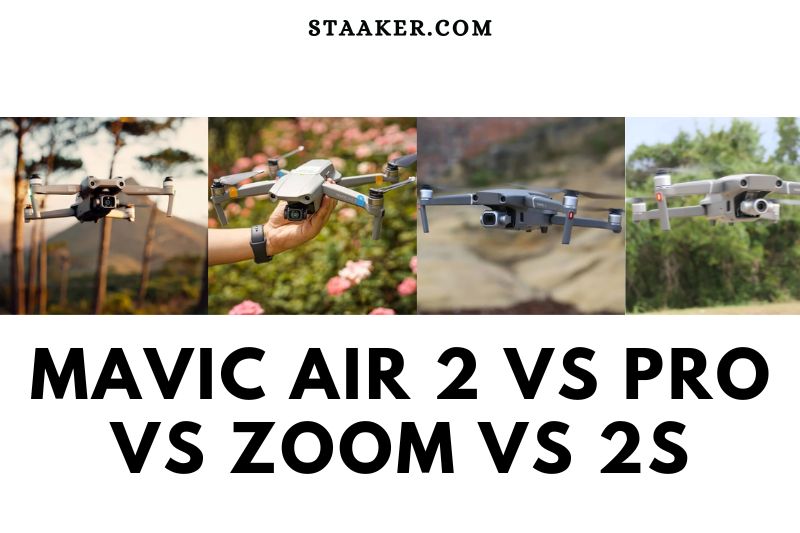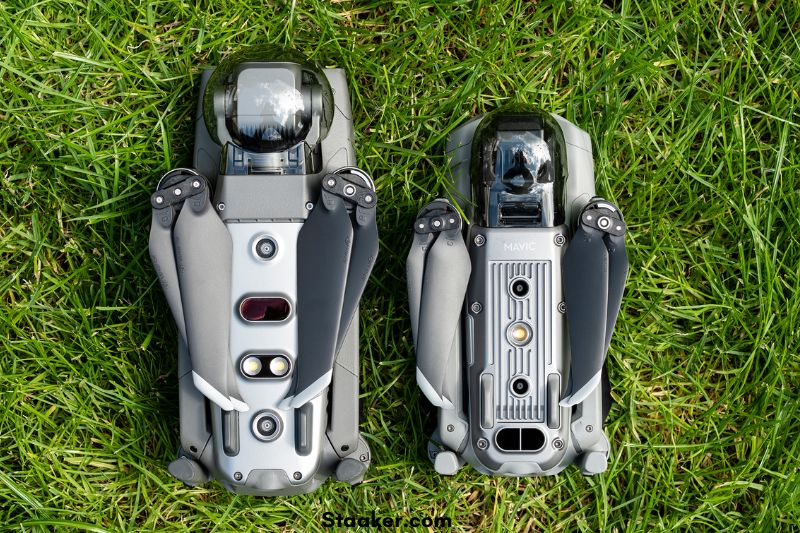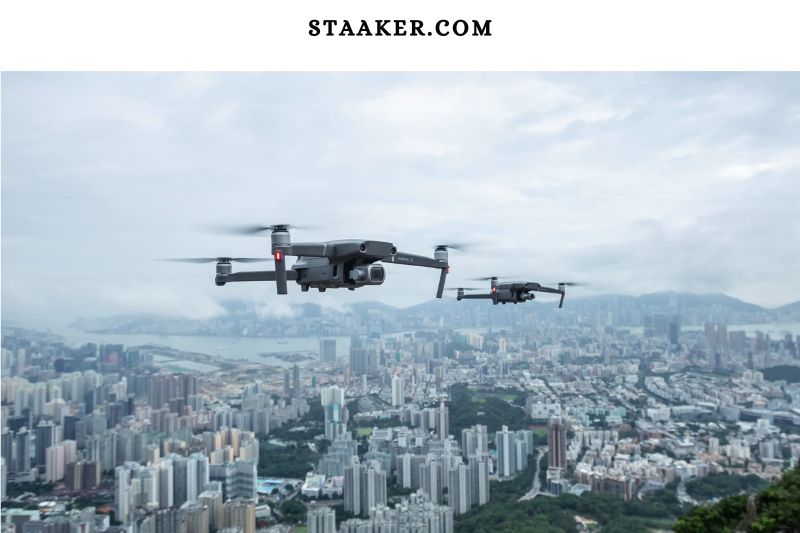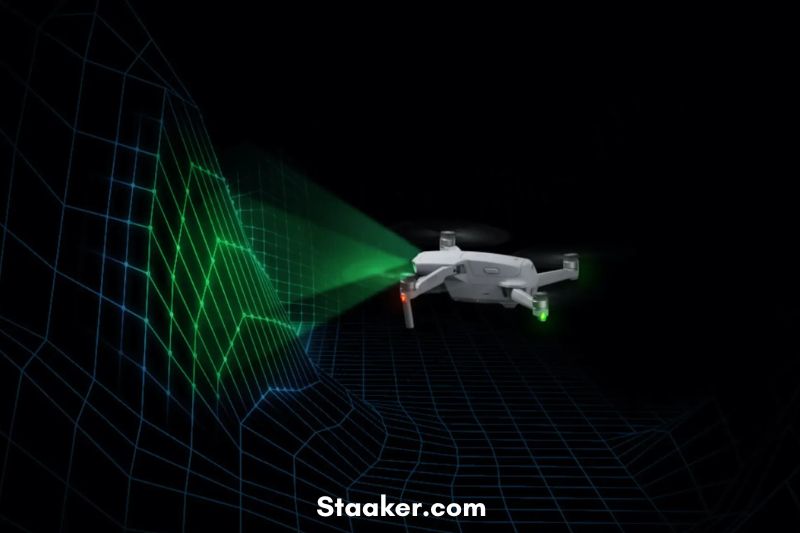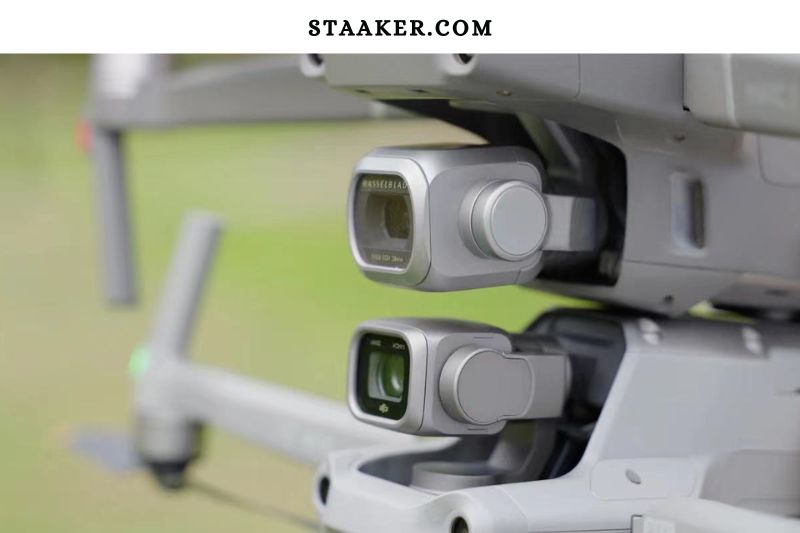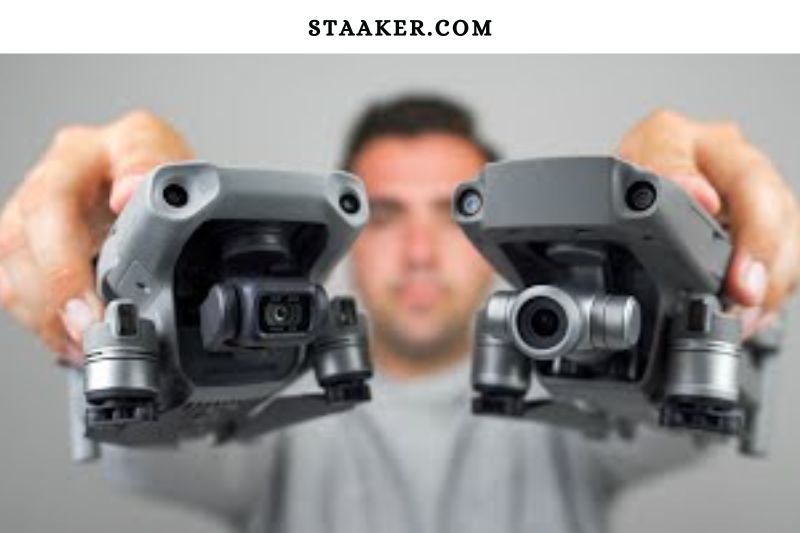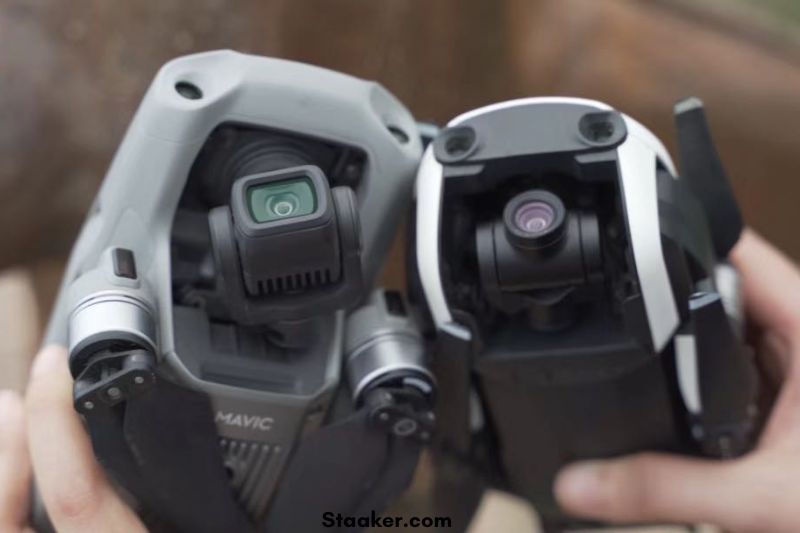When it comes to drones, the Mavic Air 2 vs Pro vs zoom vs air 2s are four of the most popular on the market. They are both great drones. They both have their strengths and weaknesses. The Mavic Air 2 is better for beginners, while the pro is better for more experienced pilots.
So which one is the better choice? It depends on your needs.
Mavic Air vs Mavic Air 2 Vs Mavic Mini vs Pro Vs Zoom Vs 2S
Design and Controller
- Both drones have a similar folding structure and a nearly comparable appearance.
- Despite being bigger, the Mavic 2 Pro is still a very portable option.
- There is a new, larger controller on the Mavic Air 2.
Mavic Air 2 vs Mavic 2 Pro vs 2 Zoom vs Air 2s
The Mavic Air 2 deviates from the DJI Mavic Air’s initial design by using the same folding mechanism as the Mavic 2 Pro and has a much higher build quality than its predecessor.
The Mavic 2 Pro, for example, has always been a great travel drone, but at 907g, it is significantly heavier than the more recent Mavic Air 2 (570g) and Air 2S (595g), making these newer models even easier to transport.
The difference between Mavic Air and Mavic Air 2 weight savings keep increasing when you factor in the battery weights of 198g for the Mavic Air 2 and 297g for the Mavic 2 Pro. Despite its size and weight, the Mavic 2 Pro continues to be a highly portable alternative and shouldn’t necessarily be disregarded. However, the Mavic Air 2 is the smaller and more lightweight of the two.
The Mavic Air 2’s controller is different from the folding Mavic Pro models in that it lacks an LCD screen for extra flight, drone, and camera information. Because of this, the controller is bigger, but it also has better battery life and can fly farther between charges than the Mavic 2 Pro controller.
However, given how little the Mavic Air 2 is by itself, it’s still odd that DJI abandoned the folding controller concept.
there is not much to compare Mavic 2 Pro and Mavic 2 Zoom here, but this is an excellent time to emphasize how wonderful it is. The Mavic 2 is an improved version of the original Mavic Pro (the initial Mavic received the suffix ‘Pro’ even though there was no alternative).
The drone folds to a compact 2149184 mm and opens back-legs-then-first with hinges in opposing planes; all I can say is that you get used to it. Due to the folding propellers (centripetal force extending them when in use) keeps the size compact, and the winglet design significantly reduces propeller noise compared to earlier drones (albeit not stealthy).
The battery forms a large portion of the fuselage and protrudes from the rear, while the drone includes vision sensors of varying abilities on each surface to aid in collision detection; those on the front and rear are spaced apart like eyes to provide binocular vision, whereas those on the sides are singular and of limited utility.
The drone is equipped with two bright white LEDs to illuminate the area beneath it, which helps see objects and landing sensors.
These DJI drones are the best available.
MAVIC MINI VS MAVIC AIR 2 VS MAVIC 2
All Mavic models now have the same design and are finished in a matte, light grey color. The main selling point of the Mavic Mini’s design is, of course, its weight and size, which places it within the weight class for most countries’ drone regulations and restrictions. When folded, the Mavic Mini can fit in the palm of your hand. The Mavic Mini and Mavic 2 cannot be compared in terms of flight and camera performance.
The Mavic 2 is designed for semi-professional users; it is still DJI’s Mavic model with the largest camera sensor, which provides the best picture and video quality. In terms of flight and technology, the Mavic 2 is also more powerful. The Mavic Air 2 falls somewhere between the Mavic Mini and the Mavic 2 in terms of camera quality, size, and drone flight performance.
The Mavic Air 2 also has a fold-down design and, when fully folded, has the surface area of a large Smartphone. The drone weighs 570 grams and is roughly the same size as the Mavic Mini and Mavic 2. The Mavic Air 2 is designed in the same way as the Mavic 2 and Mavic Mini.
The Mavic 2 series includes the Mavic 2 Pro and Mavic 2 Zoom, which are identical planes with different cameras. The Mavic 2 series has a foldable design, which is shared by all Mavic Series. When folded, the drones measure 2149184 mm (LWH) and 32224284 mm (LWH) when unfolded. The Mavic 2 series has a dark, matte grey color and is the largest of the Mavics, but it is still extremely compact, portable, and easy to transport. The Mavic 2 Pro weighs slightly more than the Mavic 2 Zoom due to its larger camera.
Mavic Air Vs Mavic Air 2
- 168 x 83 x 49 mm Mavic Air (folded)
- 180 x 97 x 84 mm Mavic Air 2 (folded)
- Mavic Air weighs 430 g.
- Mavic Air 2 weighs 570 g.
- Each is foldable
- Mavic Air comes in a variety of colors; Air 2 is grey.
The Mavic Air 2 seems to reflect a slight shift in philosophy. The second appears to be about providing a severe, high-performance consumer drone that rivals some of the more expensive models. In contrast, the first was about an entertaining little drone available in vibrant colors (if not better in some instances).
To achieve this, the new model is only presently displayed in a shade of grey comparable to the rest of the Mavic series; the original came in red, black, and white.
Though not the only design modification. To match the Mavic 2 and Mavic Mini, the tiny, almost bulbous design has been replaced with a more angular shark-like appearance. In addition, it is significantly larger and heavier than the first Mavic Air.
That doesn’t mean it’s large and hefty. It’s still straightforward to fold and carry around in a backpack at 570 grams. Although it weighs only 140 grams more than the original Mavic Air, the larger battery is primarily responsible for the weight and slight increase in bulk.
Specs and Features
- Up to 1080/240p and 4K/60p, slow-motion videos are captured by the Mavic Air 2.
- Up to 1080/120p and 4, K/30p can be captured by the Mavic 2 Pro.
- Mavic Air 2 can also capture 8K-resolution hyperlapses.
DJI Mavic Mini Vs Mavic air 2 vs 2 Pro vs 2 Zoom
The Mavic Air 2 offers twice the frame rate for slow-motion footage at 240fps at 1080p, compared to the Mavic 2 Pro at 120fps, despite the Mavic 2 Pro having superior image quality than the Mavic Air 2, which we’ll explore later.
This applies to 4K video as well, where the Mavic Air 2 again doubles the frame rate, allowing for video capture at up to 60 frames per second as opposed to the Mavic Pro’s 30 frames per second.
The two drones are once more comparable in terms of intelligent flight modes, and one doesn’t outperform the other unless you count the Mavic Air 2’s better follow/tracking modes and capacity to record hyperlapses in up to 8K.
Since so few people own 8K TVs, this may not be very helpful right now, but it does offer some degree of future-proofing because this technology will become more and more common in homes.
Of course, the cameras on these drones will be a key consideration when choosing between them. The Mavic 2 Pro sports a 1-inch, 20-megapixel camera with an equivalent 28mm focal length. Contrast that with the Mavic Air 2’s smaller 1/2-inch 12MP sensor, which has a camera focal length similar to 24mm.
The differences between these sensors are most obvious while taking still pictures, but they also affect how big and how heavy each drone is. The choice between them ultimately boils down to how significant you believe these factors are to you.
Software-wise, the cameras are comparable in terms of capability, but the Mavic 2 Pro has a variable aperture and autofocus while the Mavic 2 utilizes a fixed f/2.8 aperture and hyperfocal focusing.
Mavic 2 Zoom vs Pro both offer many new camera modes, but the Zoom variant has one exclusive option. It is known as Dolly Zoom. If you are unfamiliar with Dolly Zoom, it is also known as the Vertigo effect.
Essentially, it is a visual effect in which the primary subject remains unchanged while the background becomes broader or narrower. Watch the video below to better understand what Dolly Zoom can produce.
The Mavic Mini has intelligent flight modes such as CineSmooth and four QuickShot modes, which are Dronie, Circle, Helix, and Rocket. With QuickShots, the pilot can capture stunning aerial imagery with the press of a single button.
CineSmooth mode slows down the drone to smooth out movements for a more cinematic shot. Return To Home is another intelligent flight mode that is standard on all DJI drones. It allows the drone to return to the take-off point if the battery runs low or if the user initiates it. ActiveTrack is not available on the Mavic Mini because it lacks an obstacle avoidance system.
Performance
DJI Zoom 2 Vs Air 2 vs 2 Pro vs Mavic Air 2 vs Mavic Mini
- Both drones rely on the GLONASS and GPS satellite networks.
- A little greater battery life is provided by the Mavic Air 2.
- The Mavic 2 Pro has extra sensors for avoiding obstacles.
The Mavic 2 Pro seems and feels significantly more stable in the air, despite the fact that the Mavic Air 2 and Mavic 2 Pro fly at nearly comparable speeds and have about identical wind resistance. This is most likely due to the Mavic 2 Pro’s larger foldable low-noise propellers, which are used by both drones.
Both drones have forward, backward, and downward obstacle avoidance sensors, albeit the Mavic Air 2’s are a little bit more accurate. Both drones also employ GPS and GLONASS satellite systems. But the Mavic 2 Pro responds with side and upward sensors.
When flying normally, you won’t notice a change until you encounter more challenging situations, like flying through trees, for instance. OcuSync 2.0 is used for video transmission, and both drones perform admirably.
Despite employing smaller and lighter batteries, the Mavic Air 2 outperforms them in terms of battery life; this is evidence of how quickly battery technology is evolving. The Mavic 2 Pro is rated for up to 31 minutes at 25 kph with no wind, although the maximum flying time is advertised as 34 minutes without wind.
The Mavic Air 2’s battery life does outperform the Mavic Pro 2’s in actual flying settings, but neither drone will frequently hit these maximums due to factors like wind, temperature, and minimum battery levels (for instance, 20%).
The Air 2S has some impressive performance improvements.
Transmission is one area where this new release excels.
The Air 2S can reach distances of up to 12km (FCC) or 8km using DJI O3 technology, renamed from OcuSync 3.0, and four antennas (CE).
This exceeds the transmission distances of the Mavic Air 2 and Mavic 2 Pro, which use an older version of OcuSync – OcuSync 2.0 – and have dual antennas to reach 10km (FCC) or 6km respectively (CE).
In S mode, the Air 2S is also a more agile drone, with ascent and descent speeds of up to 6 m/s. The Mavic 2 Pro has a maximum ascent speed of 5 m/s and a descent speed of 3 m/s in S mode, while the Mavic Air 2 has an ascent speed of 4 m/s and a descent speed of up to 5 m/s in S mode.
The Mavic 2 Pro has a top speed of 20m/s, while the Mavic Air 2 and Air 2S have a top speed of 19m/s.
The wind resistance of all three drones is comparable, peaking at around 10.5m/s (Level 5).
The Air 2S falls short in one area when compared to the other two: operating temperature. The Mavic Air 2 and Mavic 2 Pro can both operate in cold temperatures (-10°C to 40°C), but the Air 2S cannot (0°C to 40°C).
The Air 2S has the same maximum flight time as the Mavic 2 Pro, with a 31-minute endurance. The Mavic Air 2 wins in this category thanks to its ability to stay aloft for 34 minutes.
The Mavic Mini is powerful enough and does not compromise on performance despite its extremely small and lightweight design, with a flight time of up to 30 minutes and a maximum range of 4km. By automatically switching between 2.4GHz and 5.8GHz whenever available, the Mavic Mini maintains a strong connection with the remote controller. The Mavic Mini has impressive flight characteristics for its size, with wind speeds up to 28.4 km/h under warranty and a top speed of 68.4 km/h in S-Mode, making it incredibly stable in the air while maintaining position accurately. The Mavic Mini can be difficult to fly on windy days, and it is not recommended to fly it below 0°C.
Mavic Air vs Mavic Air 2
The battery is the main difference between the old and new Mavic Air in terms of overall performance. The Mavic Air 2 features a larger 3,500mAh battery than the original Mavic Air’s 2,375mAh battery. And that leads to significantly longer flight duration.
Because of its superiority, DJI’s Mavic Air 2 is its best-performing consumer drone in terms of flight time. A significant improvement over the meager 21 minutes offered by the first Mavic Air, the maker claims it can fly for up to 34 minutes on a full charge.
Both are operated via a physical control pad with a built-in antenna, detachable joysticks, and a grip for a smartphone. Both can fly up to 42.5 mph in “Sport” mode. The control pad’s size and design are noticeably different. It’s no longer a little controller that fits in your hand. It is significantly more extensive and has a firmer phone grip integrated into the top edge.
Camera
DJI Zoom 2 Vs Air 2 vs 2 Pro vs Mavic Air 2 vs Mavic Mini
The camera on the Air 2S is the most significant upgrade.
First, there’s the sensor. The Air 2S has a 1-inch sensor, which is quite impressive for such a small drone.
This is larger than the half-inch sensor on the Mavic Air 2, but on par with the Mavic 2 Pro.
Both the Air 2S and Mavic 2 Pro can capture 20MP still images, while the Mavic Air 2 can capture 12MP images or 48MP images by using its Quad Bayer sensor and a technique known as pixel-binning.
The DJI Air 2S and Mavic 2 Pro, on the other hand, have much better low-light performance and image quality thanks to the larger sensor and outright 20MP camera.
Content creators who use these two drones benefit from the 2.4um pixel size, which is significantly larger than the 0.8um pixel size of the Mavic Air 2.
In addition, the Air 2S has up to 8x digital zoom (including 4x at 4K/30fps), allowing pilots to get closer to their subject without having to move the drone. In comparison, a firmware update added digital zoom capabilities to the Mavic Air 2 – 2x zoom at 4K/30fps and 4x zoom at 1080p/60fps.
The Mavic 2 Pro has an adjustable aperture that ranges from f/2.8 to f/11, whereas the apertures on both Air drones are fixed at f/2.8.
In many ways, the lack of an adjustable aperture on the new Mavics, particularly the Air 2S, is a disappointing omission. DJI has mitigated this slightly by including ND Filters in the Fly More Combos of both the Air 2S and Mavic Air 2, but an adjustable aperture would have been nice as standard.
One of the most exciting aspects of the Air 2s, and where it differentiates itself from the Mavic 2 Pro and Mavic Air 2, is its impressive video-capture specifications.
According to DJI, the Air 2S can shoot a mighty 5.4K @ 30fps, as well as 4K @60fps for good measure. Its maximum speed of 150Mbps is the icing on the cake, and it is extremely impressive for a drone of this size. In fact, it is the highest quality video drone available, barring a Zenmuse-equipped DJI Inspire 2.
In comparison, the Mavic Air 2 can shoot 4K at 60fps at a maximum bitrate of 120Mbps, whereas the Mavic 2 Pro can only shoot 4K at 30fps at a maximum bitrate of 100Mbps. The Mavic 2 Pro set the standard for years, but it appears to be showing its age in this department.
Internal storage on all three Mavics is 8GB. The Air 2S and Mavic Air 2 can also use a microSD card with a capacity of 256 GB. The Mavic 2 Pro can be equipped with a microSD card, but only with a capacity of 128 GB.
The 1/2.3-inch CMOS sensor in the Mavic 2 Zoom is smaller. It supports UHD 4K video at 30fps and 12MP images, as well as 2.7K at 60fps and Full HD at 120fps. It can also take photos with a resolution of 48MP. But what distinguishes the Zoom is the 24-48 mm Optical Zoom Camera; it’s a game-changer in terms of how you can shoot with your drone; the 4x zoom with a 2x optical zoom allows you to create shots that you don’t usually see on many drones.
The camera on the Air 2S is the most significant upgrade.
First, there’s the sensor. The Air 2S has a 1-inch sensor, which is quite impressive for such a small drone.
This is larger than the half-inch sensor on the Mavic Air 2, but on par with the Mavic 2 Pro.
Both the Air 2S and Mavic 2 Pro can capture 20MP still images, while the Mavic Air 2 can capture 12MP images or 48MP images by using its Quad Bayer sensor and a technique known as pixel-binning.
The DJI Air 2S and Mavic 2 Pro, on the other hand, have much better low-light performance and image quality thanks to the larger sensor and outright 20MP camera.
Content creators who use these two drones benefit from the 2.4um pixel size, which is significantly larger than the 0.8um pixel size of the Mavic Air 2.
In addition, the Air 2S has up to 8x digital zoom (including 4x at 4K/30fps), allowing pilots to get closer to their subject without having to move the drone. In comparison, a firmware update added digital zoom capabilities to the Mavic Air 2 – 2x zoom at 4K/30fps and 4x zoom at 1080p/60fps.
The Mavic 2 Pro has an adjustable aperture that ranges from f/2.8 to f/11, whereas the apertures on both Air drones are fixed at f/2.8.
In many ways, the lack of an adjustable aperture on the new Mavics, particularly the Air 2S, is a disappointing omission. DJI has mitigated this slightly by including ND Filters in the Fly More Combos of both the Air 2S and Mavic Air 2, but an adjustable aperture would have been nice as standard.
One of the most exciting aspects of the Air 2s, and where it differentiates itself from the Mavic 2 Pro and Mavic Air 2, is its impressive video-capture specifications.
According to DJI, the Air 2S can shoot a mighty 5.4K @ 30fps, as well as 4K @60fps for good measure. Its maximum speed of 150Mbps is the icing on the cake, and it is extremely impressive for a drone of this size. In fact, it is the highest quality video drone available, barring a Zenmuse-equipped DJI Inspire 2.
For its size and weight, the Mavic Mini has a powerful camera capable of capturing excellent aerial footage. The Mavic Mini has a 1/2.3 sensor and can shoot 2.7k video at 30 frames per second as well as 12-megapixel stills. Unfortunately, it does not support 4k video, but its 2.7k video is still of high quality for the average user, and its 3-Axis gimbal provides smooth, shake-free footage.
The Mavic Mini can only shoot 12 MP JPEG photos, which may be a disadvantage for those looking to invest in still photography.
The Mavic Air 2 has a 3-axis gimbal system for ultra-smooth, shake-free footage and can shoot 4k video at 60 frames per second. The camera also has a 1/2 CMOS sensor capable of capturing 48-megapixel still images.
Mavic Air vs Mavic air 2
- Mavic Air – 12.3 megapixels “CMOS camera
- 48MP 1/2 Mavic Air 2 “CMOS camera
- 4K at 30 fps, 1080p at 120 fps for Air
- Air 2: 4K at 60 fps, 1080p at 240 fps
- both have a three-axis gimbal
- On Air 2, a new SmartPhoto mode
The Air and the Air 2 have significant differences in the camera department. The sensor of the second generation is larger and has more pixels. 48 megapixels are used instead of 12.
While you have the option to use all 48 million pixels if you so desire, DJI, by default, employs pixel binding technology that combines four smaller pixels into one larger pixel to produce a 12-megapixel image.
Additionally, there are variations in video recording capacities. Unlike the first Mavic Air, which could only shoot 4K footage at a maximum frame rate of 30 frames per second, the Mavic Air 2 can record 4K video at 60 frames per second.
It also has excellent slow-motion capture. Both devices can capture slow-motion footage in 1080p resolution, but the Mavic Air can only shoot at 120 frames per second (fps), while the Mavic Air 2 can record at a maximum of 240.
Both drones contain a three-axis gimbal for stabilizing footage as it is being recorded, improving the footage’s smoothness.
With the Mavic Air 2, DJI also unveiled a new SmartPhoto algorithm. It includes three automatic modes: an improved low light mode, an upgraded HDR mode, and an automatic scene identification and adjustment mode.
Image and Video Quality
- For professional workflows, both drones have flat video profiles.
- A notable improvement over the Mavic Air is the Mavic Air 2.
- However, altogether, the Mavic 2 Pro provides higher-quality video and stills.
Gazing at the solar farm footage, it appears that the Mavic 2 Pro has a lot greater ability to resolve detail when flying swiftly over the panels and looking down on them. Another distinction that has been clear from this clip is that the Mavic 2 Pro camera has a significantly better dynamic range than the Mavic Air 2.
The Mavic 2 Pro video shows detail in the scene where the drones fly over the panels, and the camera rises to see the sky. However, the Mavic Air 2 video shows an overexposed sky.
Although the Mavic 2 Pro enables 10-bit HDR footage, the sensor seems to have a far wider dynamic range when recording in conventional video settings as opposed to Dlog-M or HDR.
Although the ground portion of the movie was brighter than in standard video mode, the same footage was taken with the Mavic Air 2 in HDR video mode to increase the dynamic range.
In the end, sky detail was visible. The only way to use HDR video is automatic; there is no manual video control. HDR video is quite effective. Of course, using ND filters to try to maintain the shutter speed at the intended setting still involves a certain amount of guesswork.
A higher dynamic range can be captured by the Mavic 2 Pro by shooting in the Dlog-M color profile. However, the footage will have flatter colors and less contrast, necessitating color grading during editing.
The D-Cinelike flat profile, which is used by the Mavic Air 2, is similar to Dlog-M in that it must be processed during editing, but it is typically simpler to color grade than Dlog-M.
Although there is much discussion on the optimal profile, the fact that both drones have a flat profile is very helpful for producing an aerial video that can be integrated into a professional video workflow.
The Mavic Air 2 offers much-improved color rendition and noise response at higher ISO settings compared to the Mavic Air, which it replaced.
However, the Mavic 2 Pro creates more fine detail across the frame and catches colors much more naturally.
Naturally, this has an impact on the drone’s size and weight because a larger camera and gimbal are required to accommodate the larger imaging sensor.
It is difficult to argue that the Zoom is the superior camera drone, but the ability to operate a true telephoto lens may provide tangible advantages for filmmakers. If your drone is tracking from different distances, you can obtain distinct artistic options. Thus a zoom is quite interesting to filmmakers.
The limitation of 48mm (2x) does not appear to be a problem for the gimbal. A longer zoom would be preferable, but a larger zoom might exceed the realistic limitations of tremor suppression. Well, not quite…
The bigger sensor can be advantageous in low-light conditions, but more importantly, the Pro can output a billion colors via its 10-Bit color profile and supports 10-Bit Dlog-M. This is preferred in professional video editing software.
In addition, despite the lack of a true zoom, a 1.4x crop option is provided utilizing the identical pixels, which is similar to a 40mm lens, so it comes close. Only the Pro has a variable aperture, should that feature appeal to your creativity.
Adaptive Flight Modes
The Mavic Air 2 outperforms the Mavic Pro when it comes to Intelligent Flight Modes. Along with having all the same capabilities as Mavic Pro, it also has the newest and best ones, such as FocusTrack, Spotlight 2.0, QuickShots, SmartPhoto, and others.
Included in FocusTrack are ActiveTrack 3.0, APAS 3.0, and POI 3.0. Few modes are available on the Mavic Pro, and they perform less admirable than those on the Mavic Air 2.
Internal Storage
There is 8GB of inbuilt storage with the Mavic Air 2. When you forget to insert a microSD card, it serves as an excellent backup, even if it is far from enough for video-focused pilots.
Additionally, it accepts microSD cards with a UHS-I Speed Class 3 or higher. Since the Mavic Pro lacks built-in storage, always remember to include a microSD card when taking to the skies.
Safety Options
The Air 2S boasts APAS 4.0, the newest and most sophisticated version of DJI’s Advanced Pilot Assistance System when it comes to enhanced features.
In comparison to earlier iterations, the newly enhanced APAS 4.0 gives a broader field of view to detect obstructions when flying at regular speeds. For comparison, the Mavic 2 Pro has APAS, whereas the Mavic Air 2 has APAS 3.0.
With APAS 4.0, the drone’s tilt pitches forward more as pilots fly the Air 2S at higher speeds, and the newly-added upward obstacle sensor plays a crucial role in helping obstacle identification.
Video
FAQs
1. Is the DJI Air 2S identical to the Mavic Air 2?
Both the Air 2S and the Mavic Air 2 come with a slew of automated flight modes. The main distinction between the two is that the Air 2S includes upgraded versions of these modes, such as ActiveTrack 4.0 and Advanced Pilot Assistance System (APAS) 4.0, as well as a new one called MasterShots.
2. Is it possible to fly the DJI Air 2S at night?
You can fly the DJI Air 2S safely at night because it has navigational lights and can be outfitted with a strobe kit. Part 107 certification is required for commercial drone pilots. Both commercial and recreational drone pilots are required to complete free night flying training.
- Read more: How To Spot A Drone At Night
3. How far can my Mavic Air 2 fly?
11.49 miles
The flight range of the Mavic Air 2 is 11.49 miles (18.5 km). NOTE: It is never a good idea to test your drone’s flight range, video transmission range, or battery capacity. This can cause the drone to crash or lose control.
Conclusion
So which one is the best drone of these 4? We can tell you that all 4 are excellent drones, each with its own advantages and disadvantages. It really depends on what you need a drone for. If you want the best image quality, go for the Mavic 2 Pro. If you want the best video quality, go for the Mavic Air 2. If you want a drone that is easy to fly and takes great photos and videos, go for the DJI AIR 2S.

